While many sectors of the silver market have taken a beating in recent years — the downturn in 18th-century English and American silver being a prime example — the silver of the Danish firm Georg Jensen has continued to hold its value.
What has made the Jensen market continue to thrive? First and foremost, Georg Jensen is still a going concern, with retail stores worldwide. The firm’s advertising and sales efforts drive the market for its silver flatware and hollowware patterns, with sales in Asia a particular bright spot. Additionally, there is an active secondary market for Jensen silver — at auction or through dealers — where you can acquire vintage Jensen pieces at what can be a fraction of the cost of new production.

But much of the Jensen market’s strength is due to a stellar group of designers who kept churning out designs that anticipated and reflected the styles of the day. There is an enormous breadth to the firm’s design — from Arts and Crafts to Art Deco to Scandinavian Modern. The firm also cleverly applied successful designs, such as the Grape or Blossom patterns, across a multitude of objects. For example, you can easily outfit a dining room table with the same motif on flatware, wine goblets, serving dishes and candelabra. Jensen silver also complements both modern and traditional interiors and is especially favored by contemporary art collectors. Over time, many Jensen designs have achieved iconic status, most notably the Grape, Pyramid, Blossom, Acanthus and Cactus patterns. These designs are instantly recognizable as Jensen, much like a Hermès bag, signaling both quality and luxury.
The firm has its roots in Copenhagen in 1904, when Jensen (1866-1935), a sculptor and silversmith, opened a shop selling silver jewelry and, soon after, silver hollowware. Jensen worked in the Arts and Crafts and Art Nouveau styles, drawing inspiration from nature. Flowers and fruits are the predominate motifs and Jensen’s most famous designs are the Blossom and Grape patterns.
Jensen wisely sought to expand his market beyond Denmark — opening his first international store in Berlin in 1909 and following in Stockholm, Paris, London and New York in 1921. Jensen also promoted his work through international exhibitions, winning awards and gaining new clients. William Randolph Hearst was apparently so enamored of the Jensen display at the 1915 Pan Pacific Exposition that he acquired it in its entirety — just one of many Americans to fall in love with Jensen silver. Sadly, business acumen was not Jensen’s strength and he lost control of the firm in 1924. Years of acrimonious relations with his eponymous firm followed.
Jensen’s collaboration with other designers expanded the firm’s repertoire beyond naturalistic motifs and ensured that the firm remained stylistically relevant. The firm’s support of innovative and long-tenured designers was the key factor in its continued success. Johan Rohde (1856-1935) was of foremost importance to Georg Jensen’s early years, joining in 1917 and remaining until his death. Rohde’s work eschews Jensen’s naturalism, limits ornament and reflects more classical influences. Among his best-known designs are the Acanthus and Acorn patterns.
Jensen’s brother-in-law Harald Nielsen (1892-1977) joined the firm in 1909, remaining until the 1960s. Nielsen served as the firm’s artistic director and was a prolific designer in his own right, able to work in both Jensen’s and Rohde’s style. He was also drawn to the geometric shapes of Modernism, as exemplified by his most famous design, the Pyramid pattern. Also producing for Jensen in the Modernist style was Sigvard Bernadotte (1907-2002), an important industrial designer who happened to be second son of King Gustav VI Adolf of Sweden and his first wife, Margaret, Duchess of Scania, a granddaughter of Great Britain’s Queen Victoria.
Bernadotte began designing for the firm in 1931 and continued the relationship over a 50-year period.
After the Second World War, the company’s most innovative designs were realized at the hand of the talented sculptor Henning Koppel (1918-81). Koppel worked in the Scandinavian Modern style, and his jewelry and hollowware designs are completely abstract in form. Among Koppel’s most famous designs are his water pitchers — like the Anden or Duck pitcher, which reflect his training as a sculptor.
And what of value? With more than 100 years of silver production, there is a great deal of Jensen silver available on the primary and secondary markets; prices remain strong. As expected, there is premium for works of early manufacture or designs of limited production. Georg Jensen silver will no doubt remain one of the bright spots in the field of vintage silver.
For more, contact Jenny at jenny@ragoarts.com or 917-745-2730.




